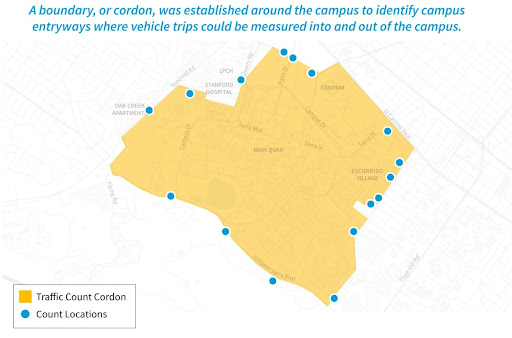[Published: April 15, 2022]
Over the past week you may have seen people wearing orange vests at various campus entrances compiling license plate numbers. You may have even heard about something called the Cordon Count. You may have wondered: What is a cordon count – a stunt dreamed up by talk show host James Corden of Carpool Karaoke fame? No, the cordon count was established by Santa Clara County to measure the number of peak-hour vehicular trips into and out of the 16 gateways to the campus, or the “cordon,” as we call it.

When do these counts take place?
Although cordon count dates vary from year to year, the County collects data for eight weeks of the year that are most representative of activity on campus. Typically they occur for six weeks in spring and two weeks in the fall. The spring 2022 cordon count began on April 11 and will last through May 20.
What is counted?
All vehicular traffic crossing the cordon, or the boundary around the campus, during the peak commute periods (7-9am and 4-6pm) is counted. The peak hours are then defined as the highest hourly volume of traffic in the peak direction occurring during the morning peak period and evening peak period. (Say that five times!) Then two adjustments are made to account for Stanford’s open campus. The first adjustment is made to exclude vehicles that pass through the campus without starting or ending their trip within the cordon. These trips are referred to as cut-through traffic. Those folks in the orange vests are actually recording the last few digits of each license plate as vehicles enter and leave the campus, and then those cut-through trips are recorded and removed from the traffic counts. The second adjustment is made by removing trips generated by hospital staff who park within the cordon and by adding trips generated by university affiliates who park outside of the cordon, near the hospitals. This is because the hospitals are located in the City of Palo Alto and have different entitlement obligations than the university, which is located in unincorporated Santa Clara County.

There are credits?
The 2000 Community Plan and General Use Permit (GUP) also specify that the County recognizes participation by Stanford in off-campus trip reduction efforts and credit reduced trips toward Stanford’s obligation to meet the No Net New Commute Trips goal, as they benefit the streets surrounding the campus. For example, when community members who are not associated with the university ride Marguerite shuttles, the university receives bonus points, or credits, toward the No Net New Commute Trips goal. More on the Stanford Community Plan and the GUP in our May newsletter.
So why, exactly, do we do these cordon counts?
One of the conditions of the 2000 GUP, defined by Condition of Approval G.4, states that "Stanford shall mitigate the transportation impacts of its additional development and population growth either through a program of 'no net new commute trips' or through proportional funding of mitigation measures for specified impacted intersections." Stanford chose the No Net New Commute Trips approach. Hence the goal is to not exceed the number of vehicles that entered and exited the university during peak hours in 2001. The cordon count is the County’s way of ensuring that the university fulfills the No Net New Commute Trips condition. In short, every trip counts! Stanford has successfully met this goal through a combination of TDM programs, an increasingly more walkable and bikeable campus, and the continued addition of on-campus housing for students and faculty.
How can I commute sustainably?
Stanford Transportation offers many programs to make your commute easier and more convenient. Please visit the Stanford Transportation website for more information about your commute resources. Reach out to the CommuteClub@stanford.edu if you have any questions.
